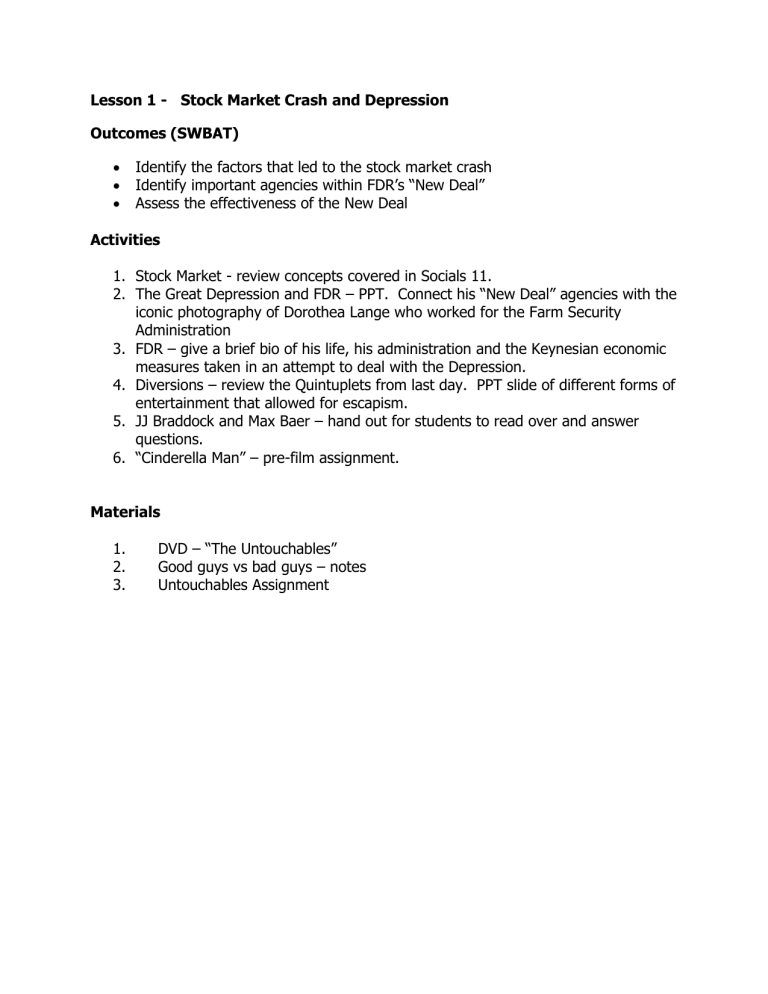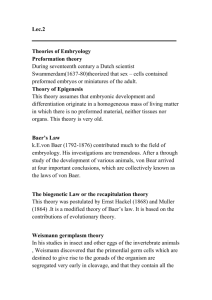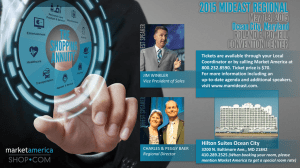here. - School District 67

Lesson 1 - Stock Market Crash and Depression
Outcomes (SWBAT)
Identify the factors that led to the stock market crash
Identify important agencies within FDR’s “New Deal”
Assess the effectiveness of the New Deal
Activities
1.
Stock Market - review concepts covered in Socials 11.
2.
The Great Depression and FDR – PPT. Connect his “New Deal” agencies with the iconic photography of Dorothea Lange who worked for the Farm Security
Administration
3.
FDR – give a brief bio of his life, his administration and the Keynesian economic measures taken in an attempt to deal with the Depression.
4.
Diversions – review the Quintuplets from last day. PPT slide of different forms of entertainment that allowed for escapism.
5.
JJ Braddock and Max Baer – hand out for students to read over and answer questions.
6.
“Cinderella Man” – pre-film assignment.
Materials
1.
DVD – “The Untouchables”
2.
Good guys vs bad guys – notes
3.
Untouchables Assignment
History Through Film 12
Ms. Lacroix
Name ___________________________
THE UNTOUCHABLES – post-film assignment
Add to your blog the following thoughts:
In our pre-film considerations you were to come up with ways that film makers utilize different techniques to portray “good guys” vs “bad guys”. Describe 2 or 3 specific scenes in the film and how effectively one or more techniques was used.
Explain any possible symbolic meanings behind the use of the colour red throughout the film.
In what way would historians attest that the character of Eliot Ness detracts from the film’s historical authenticity?
Give your overall rating out of 10 for the film and explain.
History Through Film 12
Ms. Lacroix
Name ___________________________
THE GREAT DEPRESSION IN AMERICA
Causes
FDR and the “New Deal”
Diversions:
CINDERELLA MAN – PRE-FILM ASSIGNMENT
Ron Howard – who is this and describe his Hollywood/tv background.
List the awards this film was nominated for/awarded:
James J. Braddock
From around the year 1919 to 1923 Jimmy discovered his passion for boxing.
Braddock spent a few years honing his skills as a successful amateur fighter throughout New Jersey and in 1926 entered the professional boxing circuit in the light heavyweight division. During his first year, Braddock overwhelmed the competition, knocking out opponent after opponent in the early rounds of most fights. As a top light heavyweight, Braddock thought of moving into the heavyweight class. Problem was that although he stood over six feet, two inches, he seldom weighed over 180 pounds. But even with his trim physique, Jim's powerful right hand was no match for even those opponents that weighed close to 220 pounds. Jimmy Braddock was on his way.
On the evening of July 18th 1929, Braddock entered the ring in Yankee Stadium to face Tommy Loughran for the coveted light heavyweight championship. Loughran who had studied Braddock's boxing style knew about Jim's powerful right hand and spent the match ducking and dodging Jim's punches. Braddock would never land a clean hard punch and lost the 15 round bout to decision.
On September 3rd 1929, less than two months after the Loughran bout, the stock market crashed and the nation plunged into the "Great Depression". As the banks went under, Braddock, like so many other millions of Americans lost everything.
With no work available, Jim struggled to win fights so that he could put food on the table for his wife and three young children. However, along with the economy, Jim's fight career hit the skids as well. He lost sixteen out of twenty-two fights during which time he shattered his right hand landing a punch. At the bottom of the barrel, Jim swallowed his pride, hung up his boxing gloves and filed for government relief to help support his family.
In 1934, due to a last minute cancellation, Braddock was given the opportunity to fight John "Corn" Griffin on the under-card fight for that evening's heavyweight championship fight between Max Baer and Primo Carnera. To the amazement of everyone, he went on to upset Griffin with a third round knockout.
As word of Braddock spread, he was given another chance to fight. This time the opponent was John Henry Lewis.
Once again, most predicted that Braddock wouldn't make it through the fight. Jimmy proved the critics wrong with a ten round victory.
In March of 1935, with the nation in his corner, Braddock defeated Art Lasky in 15 rounds. Jimmy later told a reporter, "So they matched Lasky and I. There was no talk about the heavyweight championship fight because they figured Lasky'd lick me. When I beat him in fifteen rounds, I hit him with everything. I mean, wherever his kisser was, I had a punch there, a left hook, a right cross, it was one of them nights."
With his win against Lasky, Braddock was now considered to be the top heavyweight contender to go up against Max
Baer. Max Baer received the reputation as a dynamite puncher and possibly the hardest hitter of all time.
On the evening of June 13th 1935 at Madison Square Garden in Long Island City NY, Braddock, a ten-to-one underdog, entered the ring to face Baer. Jim had studied Baer's boxing style just as Tommy Loughran had studied
Jim's all those years ago. Jim knew he could beat Baer if he could stay away from his hammering right hand, and that's just what he did. In an amazing feat of courage and determination, Braddock won the 15 round decision to become the new heavyweight champion of the world.
On June 22nd 1937, Braddock would defend and lose his heavyweight title in an eight round KO to "The Brown
Bomber" Joe Louis. According to Jim, Louis threw far more punches then Baer.
Prior to the Louis fight, Jim's manager Joe Gould struck up a deal that would give Braddock 10% of the gross with
Louis for the next ten years. From 1937 to 1939, Braddock received over $150,000, a lot of money in those days
(nearly two million today).
Jim Braddock was a man who wanted to go out on top and on January 21, 1938 after beating Tommy Farr after 10 rounds, Jimmy Braddock, the beacon of hope for millions, hung up his gloves and retired from the professional boxing game.
After his retirement, Jim and manager Joe Gould enlisted into the U.S. Army in 1942 where they became 1st
Lieutenants. Before the war ended, Jim served on the island of Saipan. Upon return, he helped construct the
Verrazano Bridge and worked as a marine equipment surplus supplier, running generators and welding equipment.
Jim and his wife Mae raised their three children, Jay, Howard and Rosemarie in a house they bought in North Bergen
NJ.
On November 29th 1974, after eighty-five fights with fifty-one victories, James J. Braddock died at home in his sleep.
Mae Braddock continued to live in their North Bergen home for many years before moving to Whiting, NJ where she passed away in 1985.
Daughter Rosemarie passed in 1995 and is survived by her husband Kenny DeWitt, and daughter Rosemarie DeWitt who plays a role in the movie Cinderella Man, as neighbor Sara Wilson.
Max Baer
Maximillion Adelbert Baer, better known as Max Baer, was born on February 11, 1909, in Omaha Nebraska.
Nicknamed “Madcap Maxie,” and the “Livermore Larupper,” Baer held the title of World Heavyweight Champion from
1934-35. The Boxing Register: International Boxing Hall of Fame Official Record Book said that Max possessed perhaps “the most powerful right hand in heavyweight history.”
Baer dropped out of school in the 8th grade to help his father on their cattle ranch; this labor is alleged to be the reason for Baer’s strength. Baer turned professional in 1929, and won 22 of his first 24 fights, 9 with first-round knockouts. His conditioning, combined with his tremendous power, made him a formidable foe. In 1930, he was charged with manslaughter when Frankie Campbell died as a result of a Baer knockout. He was cleared of all charges, but was banned from boxing in California for a year. Baer was so frightened by this incident that he chose to quit boxing altogether for several months.
When he returned to the ring, Baer was reluctant to attack his opponents. Hall of Famer Tommy Loughran told him he was telegraphing his punches, and Jack Dempsey worked with Baer to shorten his punches. In 1932, Baer knocked Ernie Schaaf unconscious in the tenth round of their match. Schaaf died shortly after a later fight with Primo
Carnera; however, his death was partially due to the damage inflicted by the blow he received from Baer.
In June 1933, in the best fight of his career, Baer defeated the German, Max Schmeling, in front of 60,000 spectators at Yankee Stadium. During this match, Baer wore the Star of David on his shorts, in a demonstration of pride for the
Jewish people at a time when Nazi persecution of German Jews was just beginning.
Baer received his title shot the following year. After knocking the champ Primo Carnera down 11 times, the fight was stopped in the 11th-round and Baer became the title holder.
At the height of his fame, Baer starred in a movie and lived the social high life. He was constantly romantically linked to movie stars, chorus girls, and Broadway starlets. Max Baer had two wives, actress Dorothy Dunbar (married July
8, 1931, divorced 1933) and Marry Ellen Sullivan whom he married on June 29, 1935, and remained with until his death.
In June 1935, in his first title defense, Max lost the title in a 15-round decision to James J. Braddock in a huge upset.
His next fight was a loss to Joe Louis. During the fight, Baer returned to his corner (Jack Dempsey was in his corner), and said he could not breath. Dempsey said: “I conned him into the ring...I told him I'd kill him with the water bottle if he didn't go back out there and get knocked out.” Baer was knocked out by Louis in the fourth round. He retired from boxing in 1941 with a career record of 72 wins (52 knockouts), and 12 losses. Max Baer died in 1959. He was inducted into the International Boxing Hall of Fame in 1995.








